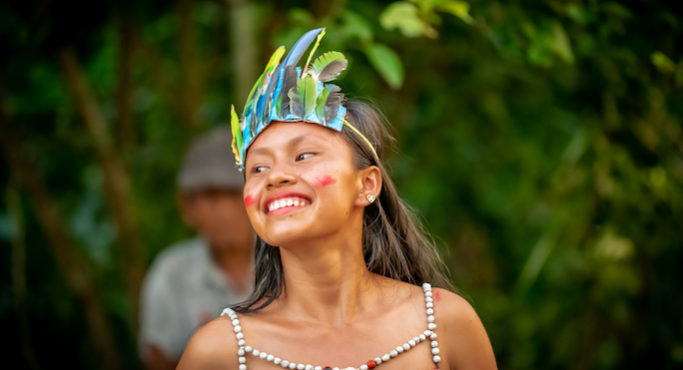By Karin Leperi
Most travelers coming to Peru head immediately to Machu Picchu, a 15th-century scenic Incan mountain retreat. It’s the most visited destination in the country. Trouble is that afterwards they incorrectly think they have seen and experienced Peru, and then head home. This is unfortunate since Peru is geographically diverse with three different cultures and climates – the Andes, the coast and the Amazon.
The most diverse is the Amazon region, covering more than 60% of Peru’s territory. Originating high in the Andes mountains, the Amazon river wends its way through six different South American countries before emptying into the Atlantic Ocean. Often called the “lungs of the world,” the greater Amazon Basin provides about 12 percent of the oxygen produced each year from photosynthesis of the region’s dense vegetation. Yet only about 5% of Peru’s population lives in the part of the country defined by the river.
Many who come to the Peruvian Amazon fall in love with the jungle. They become part of an extended tribe of global visitors who feel compelled to return year after year to experience the magical mysteries and natural wonders contained within the world’s largest rainforest, home to one in ten known earth species.
The saying goes that the jungle either loves you or spits you out. You fall madly in love with it or you focus on all the discomforts – from high humidity, heat, and rain (after all, it is called the rainforest) to annoying and deadly creatures that range from mosquitos and red-bellied piranhas to poison dart frogs and bushmaster snakes. In my case, I felt the jungle embraced me in spite of the discomforts. I learned to ignore them as I explored the abundance of wildlife through my camera.
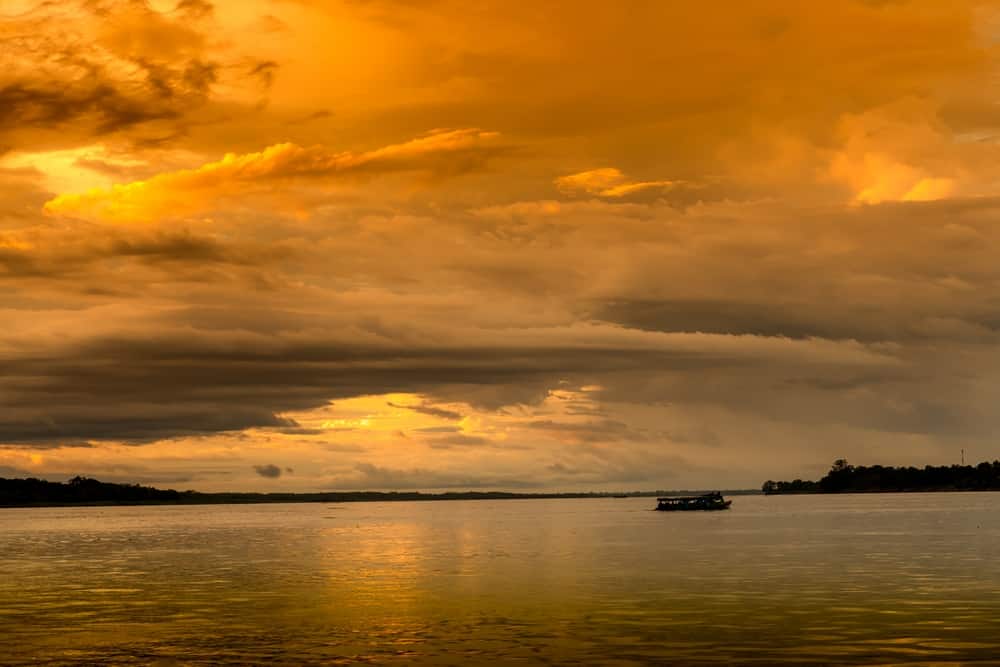
Clouds and humidity are perfect ingredients for colorful Amazonian sunsets. Photo Credit Karin Leperi
Wildlife discoveries may include three-toed sloths, capybara, caimans, tapirs, toucans, macaws, kingfishers and monkeys leaping from branch to branch in the jungle canopy. If lucky, you might spot the fabled jaguar. Although jaguar sightings in the wild are rare, the protected region of the Pacaya Samiria National Reserve is its natural habitat. Your best chance of sighting one is at water’s edge in the dry season.
Iquitos – Jungle Gateway to the Amazon
The easiest way to access the Peruvian Amazon is by air, flying from the international airport in Lima to Iquitos, a journey of 1 hour and 45 minutes. You can only go by plane or slow boat to this remote jungle city of about 500,000, because driving is not an option. There are no roads. Isolated by geography, Iquitos is the largest city in the world that essentially is an island.
Surrounded by the Amazon, Nanay, and Itaya rivers, Iquitos is the logical starting point for excursions to jungle lodges and tribal villages of the northern Amazon. It’s also, home to naturalists, guides, and crew members who staff Amazon cruises and river expeditions. Three of the leading tour companies are Jungle Experiences, Aqua Expeditions and Delfin.
For thousands of years the region belonged to Amerindians. It wasn’t until the Amazon River basin was discovered by Francisco Pizarro in 1539, that it caught the attention of Spain. Jesuit and Franciscan missionaries proselytized from about 1542 to 1864. Few others bothered with Iquitos since it was considered an outlier to the more habitable coast and Andes. Then the rubber boom hit.
In 1870, the population of Iquitos was about 1,500. By the 1880’s, the city had grown to more than 20,000 because of the world demand for rubber from trees in the Amazon forest. For about 30 years, Iquitos experienced an influx of art, culture, cuisine and architecture from Europe and abroad. Entrepreneurs and investors brought modern conveniences with them to gentrify life in the rainforest.
The bubble burst when rubber trees were smuggled to Southeast Asia. Malaya produced rubber more economically than the Amazon. By 1932, most of the Rubber Barons abandoned Iquitos as suddenly as they had come to seek their fortunes elsewhere.
Since then, the Iquitos area is financed by its reserves of oil, mineral deposits, timber, fish, agricultural crops, and tourism in the Peruvian Amazon. In 2012, the Amazon rainforest was ranked as one of the Seven Natural Wonders of the World. This has helped Iquitos to become ground zero for both land and river-based nature tourism.
It’s Different in Iquitos
With a bizarre twist, Iquitos is much like Seward’s Folly, the purchase of Alaska by the United States from Russia which at first was ridiculed as a fool’s bargain. At first blush, Iquitos seems to be a jungle folly – 2,266 miles upstream from the Atlantic Ocean and 1,155 miles from the capital of Lima. It has a wet tropical climate that features constant heat and humidity. Locals tell me you get used to it, but not everyone makes the transition to the constant rain and mosquitos. Additionally, since it is remote and inaccessible by land, everything must be airlifted or shipped by boat to this city, raising the price of goods and staples and increasing the overall cost of living.
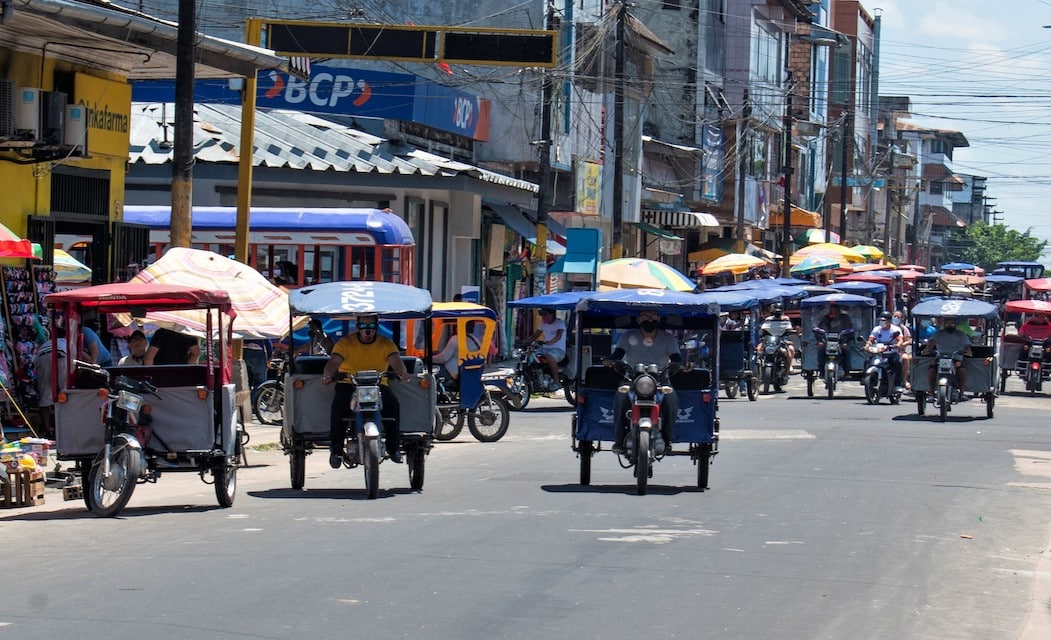
In Iquitos three-wheel mototaxis are the most efficient form of public transportation Photo courtesy of Alfredo Dosantos
The Peru of the Andes and the coast is vastly different than the Peruvian Amazon: Iquitos and the Amazon Basin are intertwined inextricably with the river and its relationship with the land. There are only two seasons: the rainy season from about October/November to May/June and the dry season from April/May to September/October. Travel is by three-wheeled mototaxis – Amazonia’s version of a taxi – as autos tend to be expensive and there aren’t too many places to drive outside of town. Surprisingly, travel by mototaxi is quite reasonable, as is public transport on the water. Family-owned canoes provide a primary source of river transportation.
One thing many people quickly discover is how friendly the people of Iquitos are. The populace seems more outgoing as there is a joy of life – alegria de la vida – that you sense everywhere. Some attribute it to the easy 85-90 degree year-round temperature that allows for an informality and spontaneous lifestyle. Others say it’s because so many of them work in travel and tourism, Whatever the reason, the jungle city is a haven for food, art, nightlife.
The Iquitos of today is a vibrant mix of native Iquitenos, Brazilians, Columbians, Chinese and African expatriates. “I love Iquitos because it is so friendly and welcoming,” says Weninger Pezo Yahuarcani, a Peruvian who grew up in Iquitos but now lives in Lima. He explains how there is a basic love of life in the jungle city that is lost in the larger Peruvian municipalities. He also prefers the year round warm weather as opposed to the dreary cold of Lima in the winter.
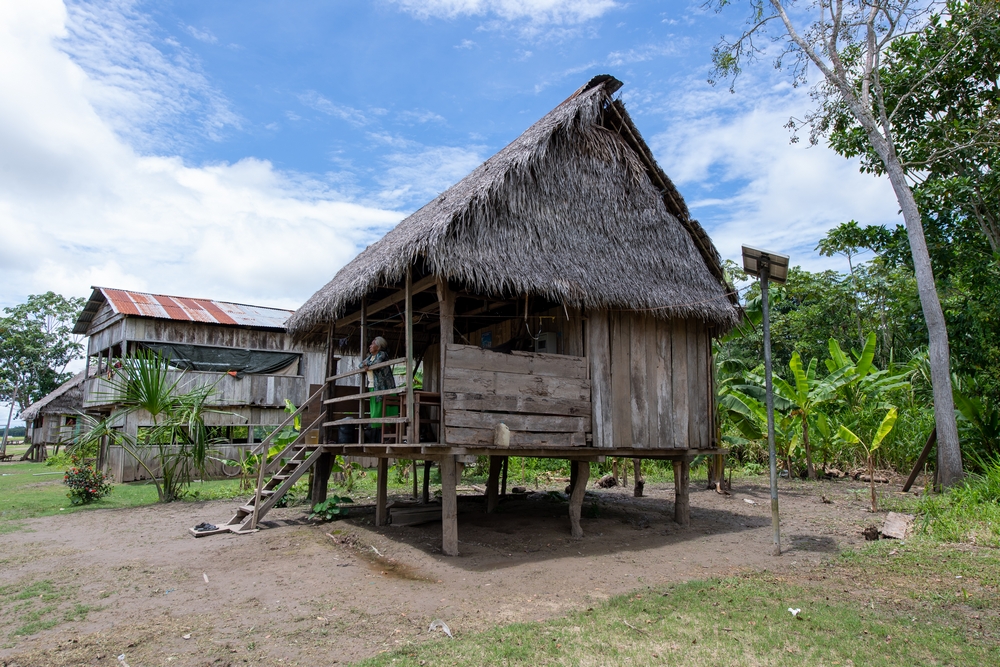
Riberenos house – Most riberenos homes are built on stilts to protect them from seasonal flooding. Photo Credit: Karin Leperi
Food & Drink
Amazonian food is different from the typical Andean foods. In lieu of potatoes, corn and quinoa, the jungle gives rice, plantain, and yuca (cassava root). And, of course, there is the plentiful bounty of freshwater fish – from pacu and paiche to catfish and piranha. In some cases, all you need is a string and piece of bait on the end. A jungle guide once told me that you never go hungry in the Amazonian jungle because there is plenty of fish, cocona and camu camu, two tasty jungle fruits rich in Vitamins B and C and antioxidants.
Tacacho is a popular dish in the Amazonas region and consists of fried slices of plantain mashed with chicharones and chorizo sausage. It is typically served for breakfast along with a dried, salted ham called cecina.
One of the most beloved Amazonian dishes is juanes – a Peruvian jungle specialty of rice, meat, boiled egg, black olives and spices wrapped in banana-like bijao leaves. Boiled in clay pots, it is served with the leaves still tied around the entrée. Don’t make the mistake I did by assuming the leaves are edible. They are not.
Feasting on juanes is a tradition on June 24, the Catholic Festival of San Juan. This is when Peruvian Amazonians celebrate their patron saint with exuberant festivities that include feasting, drinking, and dancing.
Carnival is the other important celebration in this region. Heavily influenced by Amazonian culture and river myths, carnival can last several days. Parades, dancing, and music are often accompanied by the dousing of merrymakers with buckets of water and/or mud. Be prepared to get dirty, or at least wet.
Iquitos is quite famous for the variety of liquors prepared from macerated herbs, wood and worms mixed with sugarcane rum. Many have aphrodisiac qualities and bear explicit names like Rompe Calzon – underpants breaker – also known as “one sip, one baby.”
Next to beer, sugarcane rum is the beverage of choice because of its prevalence and affordability. Also called jungle whiskey, the rum is distilled after sugarcane is crushed in a rotary press powered by a donkey who walks a circular path. Fermentation begins when the juices are stored in wooden vats.
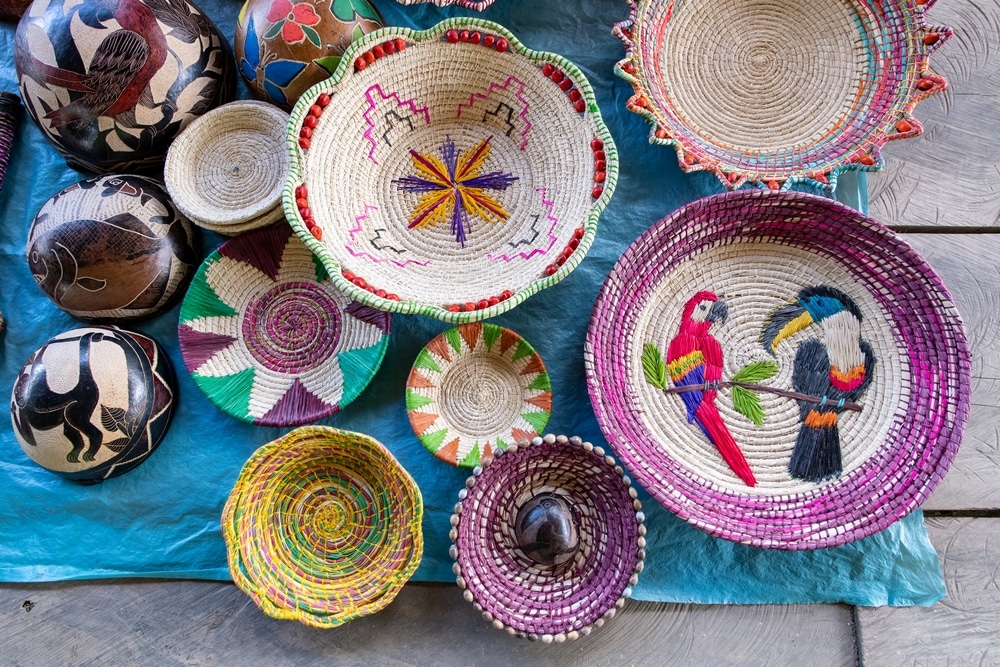
Riberenos crafts – The riberenos (river people) make and sell crafts as a way to supplement their agricultural income. Photo Credit: Karin Leperi
Of artists, artisans, and makers
For a city surrounded by nowhere, Iquitos has a surprisingly vibrant art scene. Local painters combine broad brush strokes with bold colors reflective of Amazonian pop art to create new stylistic impressions of jungle life and lore.
Though Francisco Grippa was born in Tumbes, Peru, he trained in Paris, London and New York before coming back to the Peruvian Amazon. Nowadays his style embraces texture, motion, and power, combining expressionism with figurativism. His paintings interpret nature with a free-flowing creativity powered by confident brush strokes, all derived from thousands of hours of masterful training.
Amazonian painters like Cliver Flores Lanza, a professor of art and graduate of the College of Fine Arts, paint in the style of Monet, but with a textured layering embracing bright yet natural colors, favoring jungle themes and urban life. His paintings bring an impressionistic sophistication to life in the tropics.
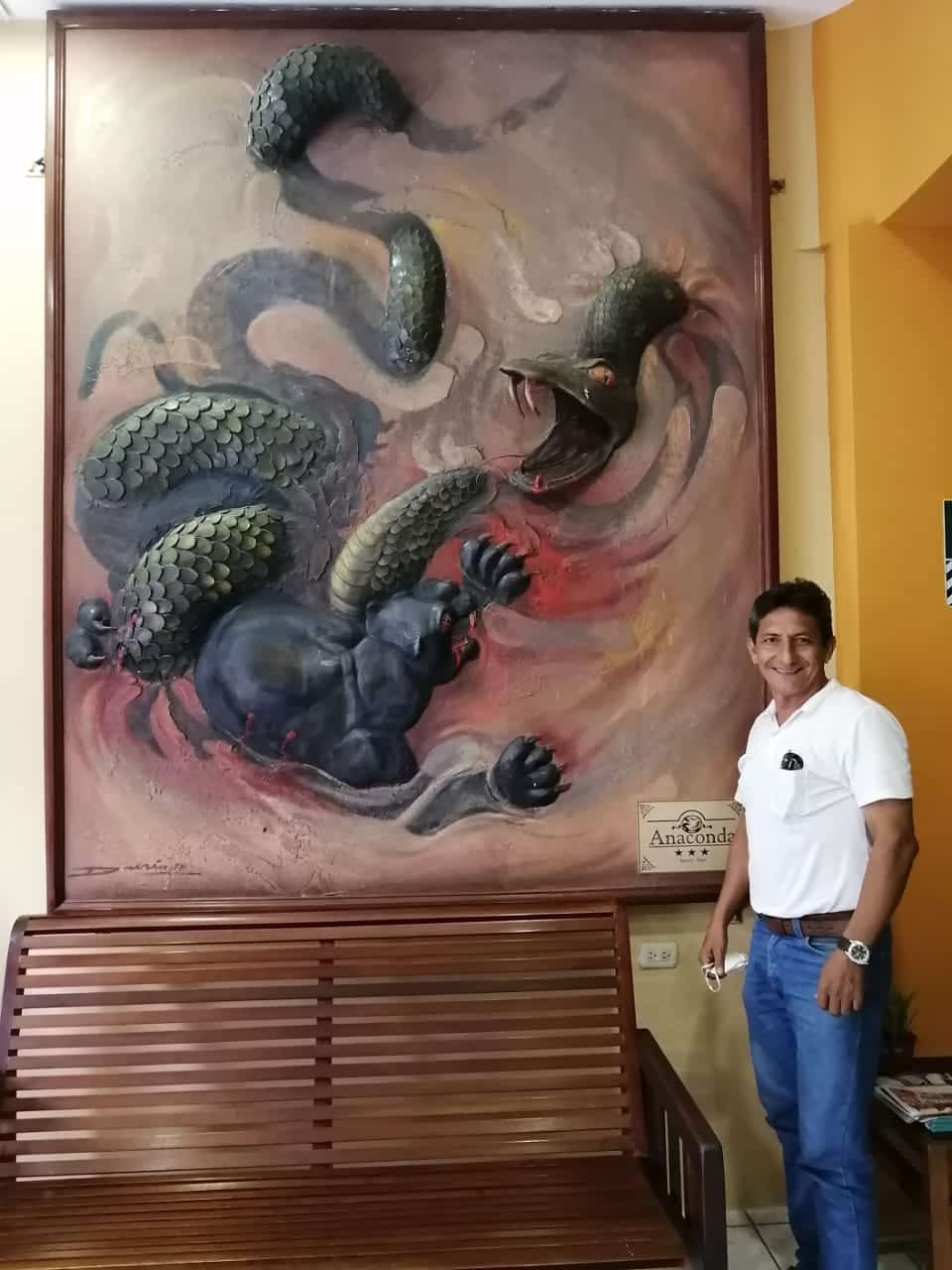
Artist Duber Rengifo Trigoso stands by his sculptured painting of an Anaconda and a black jaguar (panther). He is one of many Amazonian artists who are bringing Amazon legends back to life.
Artist, sculptor, and jewelry-maker Duber Rengifo Trigoso integrate Amazonian myth and culture into their works. They are breathing new life into Amazonian legends uniquely identifying life in the rainforest. Legends of anacondas and jaguars and pink dolphins come alive from oral history that not only remembers but preserves the stories of their cultural and storied past.
One of his three-dimensional sculptured paintings features the legendary battle between an anaconda and jaguar. Today, the large scale commission hangs prominently in the Hotel Anaconda lobby. Rengifo is also known for his fine designer jewelry, expertly interpreting the commissioned ideas of clients into shining pieces of 18k gold jewelry, including rings, engagement and wedding bands, bracelets and cuffs.
Craftsman Leoncio Nina of Artesanias Ayahuasca Iquitos makes artisan items reflecting shamanistic traditions of the vision-inducing hallucinogenic ayahuasca. Some of the jewelry incorporates wood slices of the root of the Psychotria virdis shrub, from which the traditional brew is made. Ayahuasca is a spiritual medicine used for shaman-guided visions. These handcrafted items are in demand by many tourists that come to Iquitos.
Beyond Iquitos – Riberenos and the Amazon Rainforest
Beyond Iquitos lies a region inhabited by river people known as riberenos and indigenous tribes such as the Yagua, Urarina, Matses, Matis, and Korubo. No roads traverse this hidden and isolated jungle habitat. (This is one reason why the 1980s terrorist group Shining Path never made inroads in the Amazon basin).
When the Spanish arrived to explore the Amazon basin, native people were considered subsistence hunters, fishermen and semi-nomadic farmers. They still hunt, fish and farm but today they benefit from modern firearms and manufactured goods. Some work diligently to preserve their language and cultural practices. For example, the Yagua near Iquitos derive income from opening their villages to reenactments of their traditions. Many tribes, however, are confronted by dwindling populations and the disinterest of many youth to preserving the old ways.
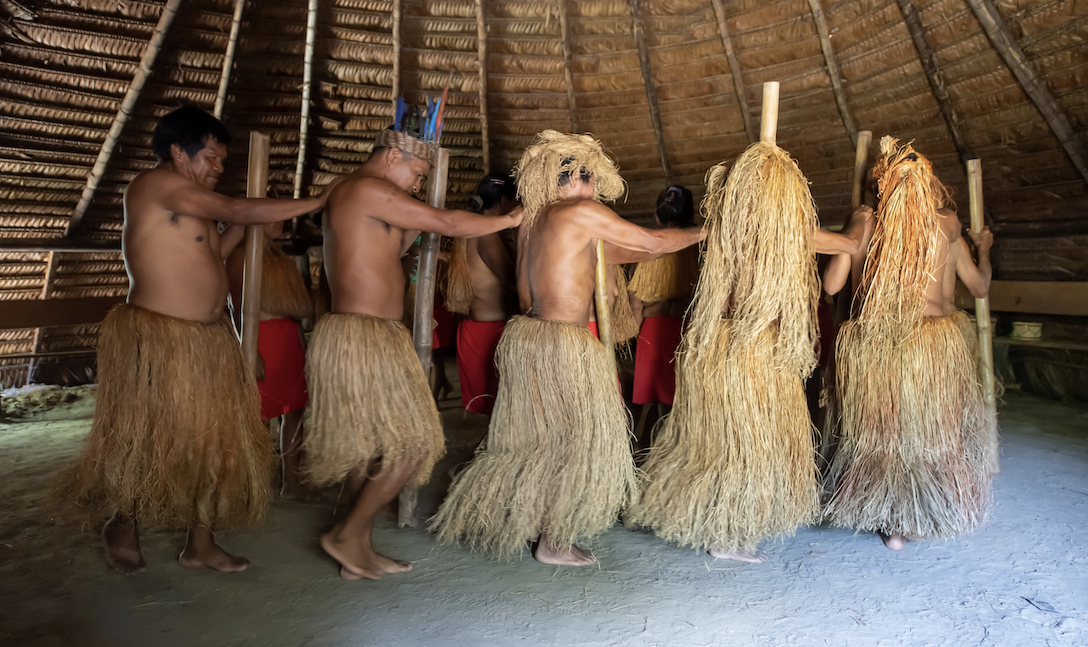
The Yagua are one of several indigenous tribes in Peru. Here they perform a ceremonial dance with traditional skirts and headdress made from reeds. Photo Credit: Karin Leperi
The riberenos of the Peruvian Amazon are ethnically diverse mestizos of indigenous, European and Asian heritage. Though culturally diverse they share a common outlook toward managing their existence in a natural world. They live simply, using the river and its ecosystem for transportation, medicine, food, and even their religion.
Riberenos are simple and resilient people used to dealing with adversity. They adapt to tourism, technology and trade by haphazardly blending the past with the present. Natives living in palm thatched huts on stilts usually have cell phones. Access to most villages comes from climbing weathered wooden planks wedged into steep embankments eroded by the constant ebb and flow of the Amazon. In many villages there are some people with electricity and a few may even own a television.
Family income derives from selling plantain, bananas, yuca and rice in weekly trips to Iquitos. Women supplement this agricultural income by selling woven baskets, carved shells, and hand-made jewelry to tourists on Amazon expeditionary cruises and visitors staying at ecolodges along the river.
The river defines daily life. It determines how people eat, sleep, work, and play. And though the river takes – drowning is one of three top causes of death – it gives back in the form of spiritual nurturing, daily sustenance and medicinal healing.
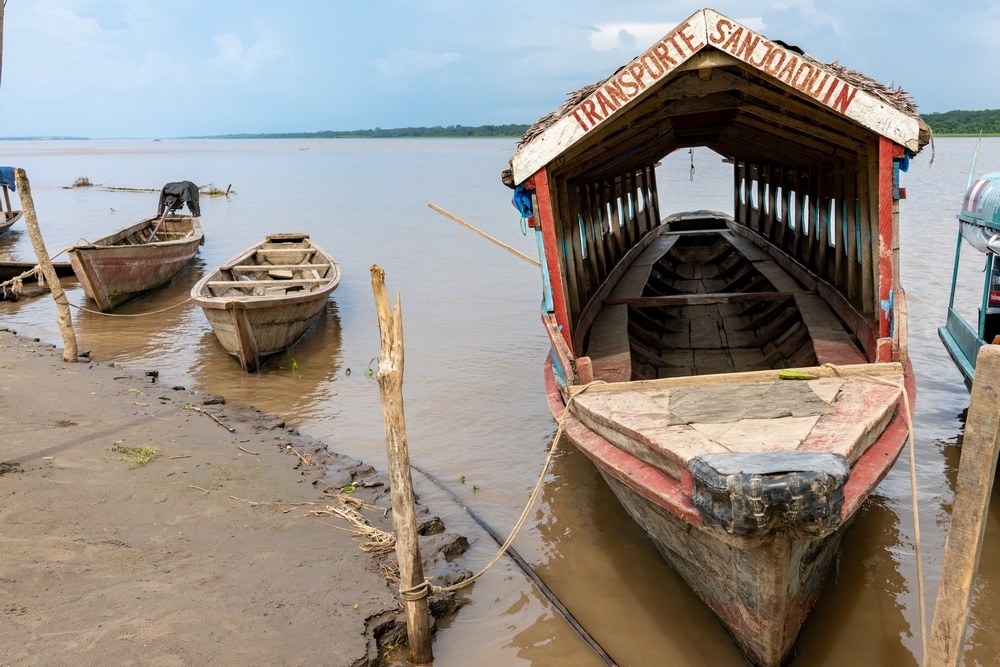
River transportation – Most people on the Amazon own a canoe or take advantage of local river transportation. Photo Credit: Karin Leperi
Cruising the Amazon
The river beyond Iquitos comprises a world of superlatives. The Amazon is the world’s longest river and its largest river by volume. It drains the largest tropical rainforest in the world.
But one doesn’t really cruise the mighty Amazon River. You meander and glide through a world of water that defies the concept of time. Life seems eternal here. Time is defined by the rhythms of the river – rainy season and not-so rainy season. The air hangs heavy, infused with humidity and the smell of wet foliage. An unexpected bonus is how the rainforest moisturizes skin. Perhaps this is why so many of those living here appear so youthful.
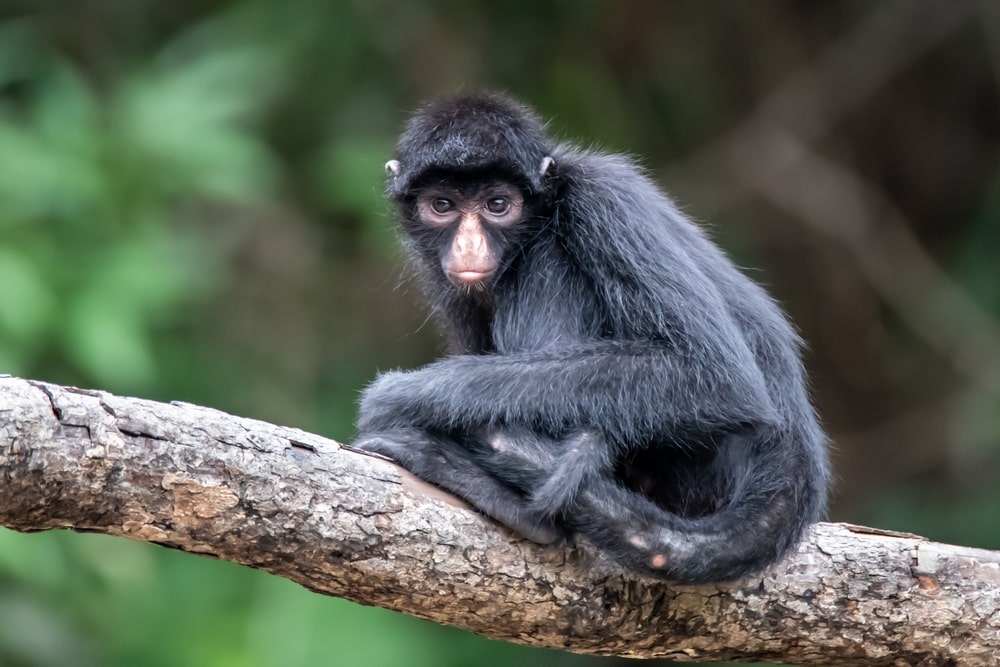
Peruvian spider monkey – Wildlife abounds in the Peruvian Amazon rainforest and draws many travelers each year. Photo Credit: Karin Leperi
Vast canopies of virgin and secondary growth forests provide refuge for birds – many endemic to Peru. I was excited to finally see the dinosaur-like Hoatzin bird and the beautiful capped heron with turquoise-radiant lores – a unique Amazon treasure. We passed tangled vines on shore along with mangroves, and areas where black-colored waters from decomposed organic matter meet the pale waters of the Amazon. It is at the confluence of these currents where the pink river dolphin likes to linger – both in legend and reality.
No matter how adaptable and resilient the riberenos may be, they live in a pivotal time for their world and our planet. Here climate change and global warming are not abstract terms. Given the current rate of deforestation throughout Amazonia, riberenos are at-risk of losing not only their homes and habitat, but also their future.![]()
As a writer-photographer based in Albuquerque, New Mexico, Karin Leperi focuses on unique people and places around the world.


